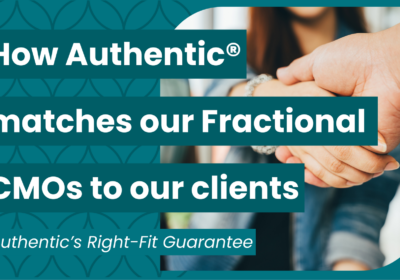
There is nothing more valuable to a business, its relationships, and its brand than the trust it creates and maintains with its stakeholders. Trust is your most valuable brand currency, one that builds on itself over time to increase your brand equity, the brand’s worth in and of itself. Companies with higher brand equity experience all types of financial benefits: greater profit margin and better customer acquisition and retention.
Building brand equity through trust can be an overwhelming effort for company founders and CEOs. But as a business leader, you don’t need to strive to achieve the brand equity of the Apples, Ikeas, and Lululemons of the world. (At least not right away.) Instead, focus on incremental ways to build trust in your business. Building this brand trust doesn’t happen by accident. It’s the cumulative result of thoughtful and strategic decisions over time.
5-phased approach to building brand trust and equity
At Authentic, we’ve worked hard to build trust in our business and, as a result, have increased our brand equity in the years since our founding. This five-phased formula is the one we followed and one that can help you successfully build brand trust to run a thriving business.
Phase one: Leverage existing relationships
When you first start a business, you come to the table with an unknown brand. It doesn’t yet have credibility, trust, or equity. The first step to build brand trust and equity begins with asking yourself:
- Who do we already know that trusts us personally?
- How do we ask or equip these people to help us?
These initial relationships are likely your own team members, former colleagues, clients, and partners, and friends and family. These people make up your immediate network, which is critical for any founder in their business’s early days.
The key to this phase is to be honest with yourself about your connected levels of influence. Some business leaders will have more clout than others. If you have already experienced entrepreneurial success, you’re likely to have a more extensive, established network of connections than someone launching their first endeavor. But everyone — no matter where they are in their entrepreneurial journey — has existing relationships they can nurture and leverage to support their growth.
When I started Authentic, I was worried about my network because my most recent professional roles were global, but I lived in Minnesota. I hadn’t had the time to recently invest in Minnesota’s local business community. However, when I announced that I was launching Authentic, I was pleasantly surprised to discover the relationships I had sowed early in my career when establishing my personal brand came back to me in spades. People were eager and willing to support me in my new journey; I just had to ask and enable them to help.
Phase two: Establish brand credibility
Phase two is when you have to prove that your business can back up what it claims to exist to do. The question to ask during this phase is,
- Who are we working with that trusts us personally and corporately?
These are typically your early customers, employees, and partners. Be mindful not to undervalue relationships with these early adopters.
The key to this phase is to deliver on all of your promises, whatever it takes. The bar is set low in business today because people and companies tend to overpromise and underdeliver. The most important thing you can do during this phase is the opposite — underpromise and overdeliver. If you and your business can be one of those rare entities that follow through on what you say you’ll do, and you do that consistently over time, you will build brand trust, which then converts to brand equity. Leverage your early successes by requesting testimonials, case studies, and referrals. These proof points establish credibility that is re-marketable, which is how you build trust upon trust upon trust.
The first Authentic clients were people I already knew or had worked with before. They knew, trusted, and believed in me. Find these people for yourself, and determine how they can help you achieve business success.
Phase three: Expand networks of trust
Phase three starts after you establish your business and ground your product or service. Now it’s time to ask:
- Who can help us scale?
- Where are there existing, established networks bigger than ours that already have trust with our future buyers?
At this point, you should understand your ideal customer profile, what matters to them, how you become part of the solution to their challenges, and know where they live, interact, and engage. Your buyers might be part of an industry association group, or maybe they buy all of their products or services from another technology provider that could propel your business forward if you had a partnership with them. Networks of trust could also be referrals into connected networks from your immediate network or early adopters, including your employees.
The key during this phase is to help. You must come to these relationships without a self-serving agenda. To build brand trust, you first must create something of value for the person or business whose help you’re seeking. For early-stage companies, this can be challenging because resources are often slim. Use your creativity to identify what you could provide of value or service to the more established entity. Once you provide value and prove your capabilities, explore ways to collaborate and naturally gain exposure into their world. This collaboration can’t be forced or manipulative; to build trust, you must genuinely care about the success of anybody you’re looking to partner with.
Phase four: Elevate brand through influence
Once you establish your trusted networks, it’s time to determine how to scale them. Ask yourself:
- What are our most established trusted networks, and how do we take them to the next level?
Look to those seeds you planted by providing value and proving your capabilities. Identify ways to harvest those seeds through third-party referrals, expanded and larger partnerships, and not just regional but national or strategic collaborations. For example, you might approach a technology partner and say, “We provided this value to you; what would you say about partnering with us to create a piece of content that we both contribute to and put a budget into?” Initiatives like this elevate your brand through engagements with more established brands.
The key to this phase is not to lose track of your business objectives. As you start developing circles of extended trust, others will have their own business objectives and ideas for how you could help them. Not every good idea is going to propel both your business and theirs. Focus on the ideas that help others and advance your business vision. Be prepared to say no if something isn’t a fit. This focus will lead you into deeper levels of trust because you know yourself well, have a direction, and understand what will serve your communities of influence best.
Phase five: Extract the personal brand
There comes the point in every business’s growth when the brand can’t live on just the founder or CEO’s reputation. Eventually, as a founder, you will likely want to take a step back, hire a new CEO, or sell the business. If you build your business closely tied to your personal brand, you eventually become a liability to the company. In this phase, ask yourself:
- How do I do the right things with my personal brand to help build and support the business without becoming a liability?
- How might I exit the business or my current role someday without damaging the corporate brand?
As you begin phases one through four of this phased trust-building, think of ways to elevate other voices in your business. Make your customers, employees, and partners the story heroes. If your goal is to maintain a small lifestyle business or be an author, keynote speaker, or independent consultant, you can be the hero, voice, and face forever. However, if you want the value to stay with the business with or without you, you have to elevate other voices in the company.
The key here is to start with the end in mind. Decide early on, as best as you can, what you want from your business, how you can be an asset and not a liability, and where’s the point where you become a liability. Plan ahead so that your personal brand doesn’t get in the way of your bigger vision.

Start building brand trust and equity today
Brand trust and influence is a multiplier effect that increases brand equity over time. Focus on building circles of trust that expand outward into a ripple effect of their connected circles of trust and influence. Eventually, your brand — and you as a branded leader — become influential even if you weren’t when you initially started. This influence helps you gain the brand equity needed to accelerate your growth.
If you haven’t already started building circles of influence, here’s how to get started:
- Share: Share your authentic personal brand
- Clarify: Be clear about what you’re trying to achieve in the short and long term
- Identify: Identify those who can help you get there
- Help: Help them first by creating value
- Do: Do what you say you’ll do — every time
- Leverage: Leverage influence to propel you into the next circle of trust
- Care: Never lose sight of the big picture and the real human relationships

Contact us if you’d like to learn how Authentic can help you sow seeds of trust and expand them thoughtfully and strategically into higher-value opportunities that elevate your brand.








